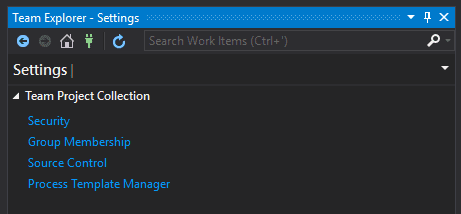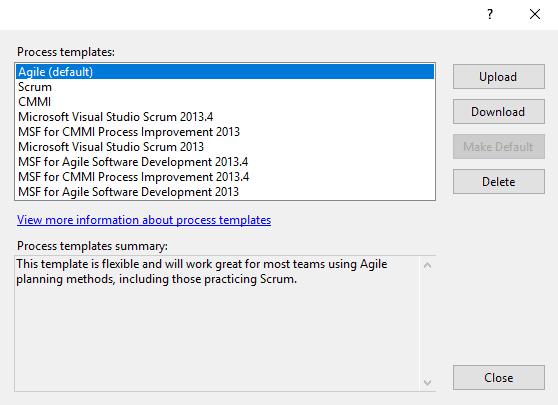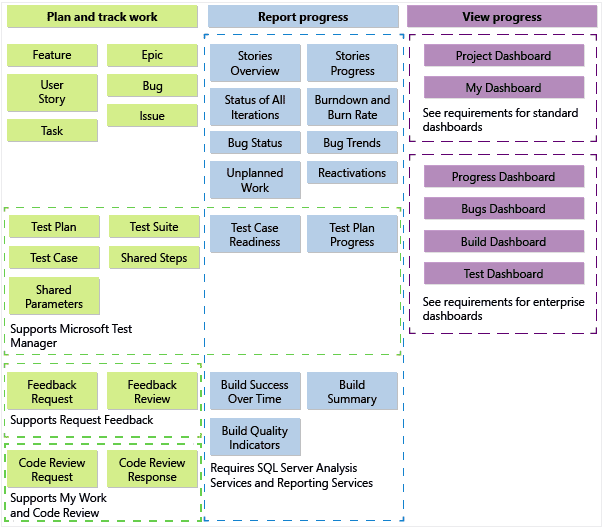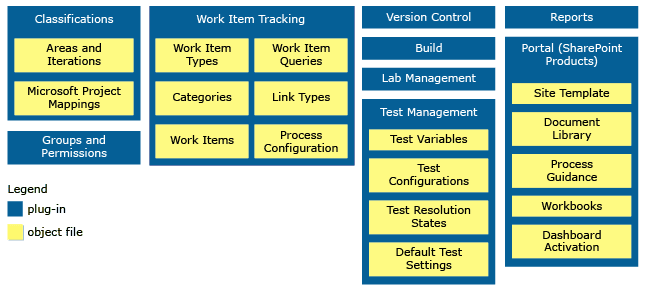Customize a process model in TFS
We have methodologies, we have processes, we have policies... all of them aiming at standardizing the way we work, and yet, even within the same company, no two teams do things in the exact same way. Everybody has a personal preference, that's what makes us unique.
So, if we are intrinsically uniques, wouldn't it be nice to have tools that adapt to our every need instead of forcing us to do things in a certain way? Guys at Microsoft certainly think so and that's why they made TFS and VSTS highly customizable.
In this post I'm going to cover the essentials that will allow you and your team to customize your TFS instance using nothing more than your favorite text editor and a simple set of commands.
The Process Model
A process model defines all the artifacts (objects and processes) available to you when you create a team project. It contains all the valid type of items, fields, and values you can use to capture requirements and track your work (time, effort, etc).
TFS and VSTS support three main process models: Agile, Scrum, and CMMI. Other
process models may be created, but they all need to inherit from one of the main
process models.
In TFS, the type of items supported by each model are defined via type definitions,
and the fields and values via layouts. Both are stored in XML Definition Files
that can be easily downloaded, updated, and uploaded back into TFS, thus making
the models highly customizable.
The whole process was revamped with the introduction of VSTS. Now is as simple as creating your own process model by extending one of the main models, and using the provided user interface to do changes to it. This is great for people that don't want to spend a lot of time customizing the process template, but still would like to do changes here and tehre. It's so simple, that I'm going to leave it out...
Download the entire process model definition
Use this approach if you are planning on creating your own process model, but
you still want to base it from an existing one.
Note: This is considered a best practice.
- Open Visual Studio
- Connect to your TFS instance using Team Explorer.
- Once connected, go to Settings in the Home tab.

- Select Process Template Manager under Team Project Collection.

- Select the template to download.

... or download just the type definition you want to update
Use this approach if you want to make updates to a specific type definition. With this, you are basically cherry picking the artifacts you want to change.
Best Practice
Instead of modifying any of the pre-existing process models, create your own by means of inheritance and do your customizations there. This makes it exportable and more manageable.
- Open a PowerShell prompt.
- Load the required tooling (
witadmin) by adding the Team Explorer folder to yourPath.$env:Path += "$env:Path;${env:ProgramFiles(x86)}\Microsoft Visual Studio\2017\Enterprise\Common7\IDE\CommonExtensions\Microsoft\TeamFoundation\Team Explorer" - Export the type definition you want to update.
witadmin exportwitd /collection:"<your_collection>" /p:"<your_project>" /n:"<type_definition>" /f:"<you_local_path_to_file>"
Customizing type definitions
Type definitions are located in the <Process_Model>\WorkItem Tracking\TypeDefinitions
folder (in case you have downloaded the entire process model) and they all have the same
structure.
| <Witd:WITD> | |
| <!-- Identifies the work item --> | |
| <WORKITEMTYPE> | |
| <!-- Describes the work item --> | |
| <DESCRIPTION></DESCRIPTION> | |
| <!-- Defines the work item fields --> | |
| <FIELDS></FIELDS> | |
| <!-- Defines the workflows followed by the work item --> | |
| <WORKFLOW></WORKFLOW> | |
| <!-- Defines the UI of the work item --> | |
| <FORM></FORM> | |
| </WORKITEMTYPE> | |
| </Witd:WITD> |
Updating the fields
Fields are used as the backing store of the item. This doesn't mean in any way that every single field is available to the user, some fields are calculated on the fly when another field changes its value, others are used as control values, and of course, there are fields that map directly to a control in the UI.
Adding, removing and updating fields is as simple as adding, removing and
updating the corresponding <FIELD> nodes under <FIELDS>. So I won't waste time
explaining this, instead I will show how to accomplish some common tasks related to fields.
- Add help text.
Use<HELPTEXT>to provide a nice tool tip.
... <FIELDS> <FIELD name="Priority" refname="Microsoft.VSTS.Common.Priority" type="Integer" reportable="dimension"> <HELPTEXT>Importance to business</HELPTEXT> </FIELD> </FIELDS> ... - Make it required
Use
<REQUIRED />to mark the field as required.
... <FIELDS> <FIELD name="Title" refname="System.Title" type="String" reportable="dimension"> <REQUIRED /> </FIELD> </FIELDS> ... - Make it readonly
Use
<READONLY />to mark the field as readonly.
... <FIELDS> <FIELD name="Closed Date" refname="Microsoft.VSTS.Common.ClosedDate" type="DateTime" reportable="dimension"> <REQUIRED /> </FIELD> </FIELDS> ... - Make it depend on a different field
Use
<WHENCHANGED field="<field_name>">or<WHENNOTCHANGED field="<field_name>">to make the field depend on the presence or abscense of another field's value.
... <FIELDS> <FIELD name="State Change Date" refname="Microsoft.VSTS.Common.StateChangeDate" type="DateTime"> <!-- Set the current time when State changes --> <WHENCHANGED field="System.State"> <SERVERDEFAULT from="clock" /> </WHENCHANGED> <!-- Make the field readonly if State hasn't changed from the original value --> <WHENNOTCHANGED field="System.State"> <READONLY /> </WHENNOTCHANGED> </FIELD> </FIELDS> ...
Updating the workflows
Items are treated as state machines. So workflows are state machine operations that describe the item at any specific point in time.
This section can be divided into two main sub-sections: States and Transtions.
A state describes the characteristics of the item at a particular point in time.
It's mostly used to calculate field values and apply validations (make a field
readonly or required).
| ... | |
| <STATE value="Done"> | |
| <FIELDS> | |
| <!-- Clears the Remaining Work field when the state is Done --> | |
| <FIELD refname="Microsoft.VSTS.Scheduling.RemainingWork"> | |
| <EMPTY /> | |
| </FIELD> | |
| <!-- Marks Closed Date as required and sets the value to the current date/time --> | |
| <FIELD refname="Microsoft.VSTS.Common.ClosedDate"> | |
| <REQUIRED /> | |
| <SERVERDEFAULT from="clock" /> | |
| </FIELD> | |
| </FIELDS> | |
| </STATE> | |
| ... |
A transition describes the actions taken when an item transitions from one state
to another. It's used mostly to update field values (i.e. populate lists based on
the state of the item), but can be also be used to calculate field values, although
this is usually done at the state level, because of the number of transitions that
could lead to a particular state.
| ... | |
| <TRANSITION from="" value="New"> | |
| <REASONS> | |
| <REASON value="Build Failure"> | |
| <DEFAULTREASON value="New defect reported" /> | |
| </REASONS> | |
| </STATE> | |
| ... |
So, if I would like to add a new state, I would do something like:
| ... | |
| <WORKFLOW> | |
| ... | |
| <STATE value="Waiting Verification"> | |
| <!-- Updates the value of the Activity field to Testing --> | |
| <FIELD refname="Microsoft.VSTS.Common.Activity"> | |
| <COPY from="value" value="Testing"> | |
| </FIELD> | |
| </STATE> | |
| ... | |
| <TRANSITIONS> | |
| <TRANSITION from="In Progress" to="Waiting Verification"> | |
| <REASONS> | |
| <DEFAULTREASON value="Development finished" /> | |
| </REASONS> | |
| </TRANSITION> | |
| <TRANSITION from="Waiting Verification" to="In Progress"> | |
| <REASONS> | |
| <DEFAULTREASON value="Needs fixing" /> | |
| </REASONS> | |
| </TRANSITION> | |
| <TRANSITION from="Waiting Verification" to="Done"> | |
| <REASONS> | |
| <DEFAULTREASON value="Reviewed" /> | |
| </REASONS> | |
| </TRANSITION> | |
| </TRANSITIONS> | |
| </WORKFLOW> | |
| ... |
Updating the UI
This is probably the section that will contain the most configurations, but it all will depend on the number of layouts you are planning to support (web, desktop, mobile, etc).
The section can be divided into two main sub-sections: Layout and WebLayout.
In Layout, you define the layout to be used by non-browser devices (visual
studio, mobile apps, etc). Before TFS 2017, this was the only available section,
so if you are using TFS 2015 or below, this is the section you want to update.
Best Practice
Even if you are currently using TFS 2015 or below, it is advisable to update both sections (`Layout` and `WebLayout`), this way the type definition will be compatible with all versions, making it more robust.
In WebLayout, you define the layout to be used by browsers (web). Support for
multiple browsers and device sizes is possible via the properties of the node.
This whole section looks a lot like xaml, so I will stop right here. I added
a few links in the references that explain how this whole section works.
Upload XML Definition Files
- Open a PowerShell prompt.
- Load the required tooling (
witadmin) by adding the Team Explorer folder to yourPath.$env:Path += "$env:Path;${env:ProgramFiles(x86)}\Microsoft Visual Studio\2017\Enterprise\Common7\IDE\CommonExtensions\Microsoft\TeamFoundation\Team Explorer" - Export the type definition you want to update.
witadmin importwitd /collection:"<your_collection>" /p:"<your_project>" /f:"<you_local_path_to_file>"
References
All FORM XML elements reference
Customize a process template
Import, export, and manage work item types
Add and manage fields for an inherited process












